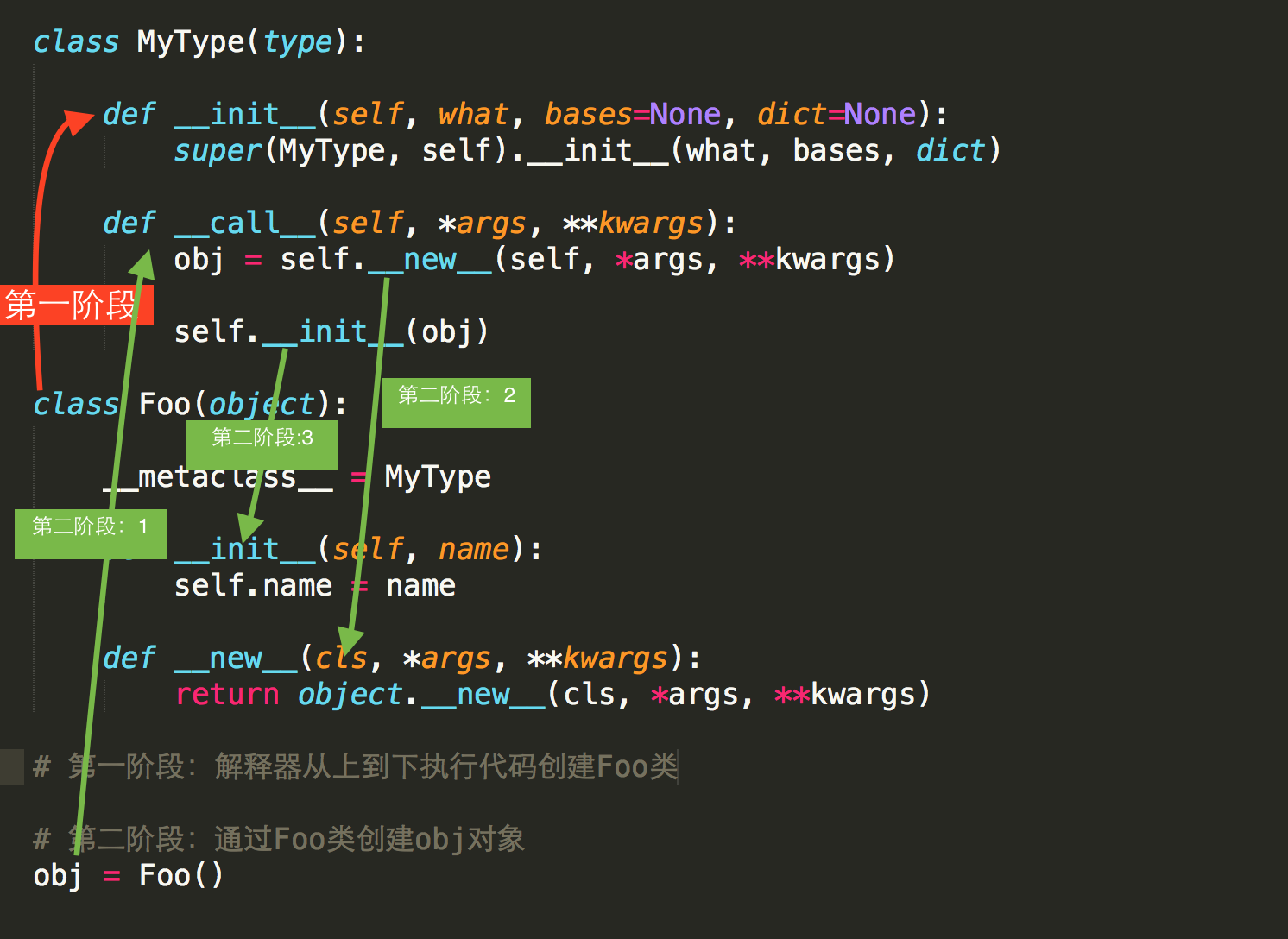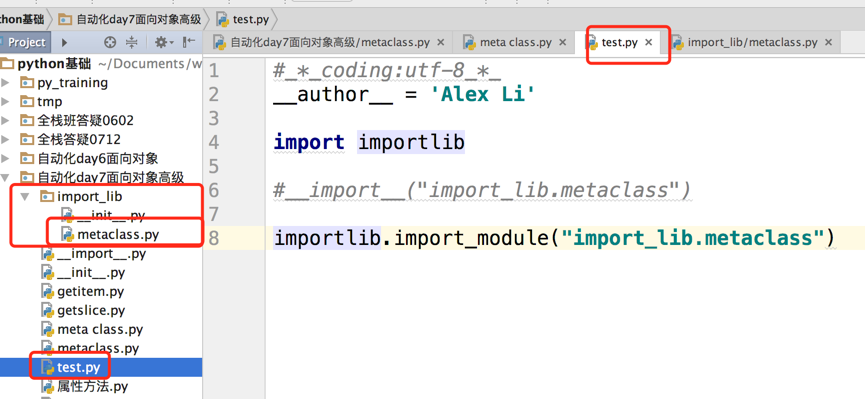Python基础7 面向对象编程进阶
本节内容:
- 面向对象高级语法部分
- 经典类vs新式类
- 静态方法、类方法、属性方法
- 类的特殊方法
- 反射
- 异常处理
- Socket开发基础
- 作业:开发一个支持多用户在线的FTP程序
面向对象高级语法部分
经典类vs新式类
把下面代码用python2 和python3都执行一下
|
1
2
3
4
5
6
7
8
9
10
11
12
13
14
15
16
17
18
19
20
21
22
23
24
|
#_*_coding:utf-8_*_class A: def __init__(self): self.n = 'A'class B(A): # def __init__(self): # self.n = 'B' passclass C(A): def __init__(self): self.n = 'C'class D(B,C): # def __init__(self): # self.n = 'D' passobj = D()print(obj.n) |
classical vs new style:
- 经典类:深度优先
- 新式类:广度优先
- super()用法
抽象接口
|
1
2
3
4
5
6
7
8
9
10
11
12
13
14
15
16
17
18
19
|
import abcclass Alert(object): '''报警基类''' __metaclass__ = abc.ABCMeta @abc.abstractmethod def send(self): '''报警消息发送接口''' passclass MailAlert(Alert): passm = MailAlert()m.send() |
上面的代码仅在py2里有效,python3里怎么实现呢?
静态方法
通过@staticmethod装饰器即可把其装饰的方法变为一个静态方法,什么是静态方法呢?其实不难理解,普通的方法,可以在实例化后直接调用,并且在方法里可以通过self.调用实例变量或类变量,但静态方法是不可以访问实例变量或类变量的,一个不能访问实例变量和类变量的方法,其实相当于跟类本身已经没什么关系了,它与类唯一的关联就是需要通过类名来调用这个方法
|
1
2
3
4
5
6
7
8
9
10
11
12
13
|
class Dog(object): def __init__(self,name): self.name = name @staticmethod #把eat方法变为静态方法 def eat(self): print("%s is eating" % self.name)d = Dog("ChenRonghua")d.eat() |
上面的调用会出以下错误,说是eat需要一个self参数,但调用时却没有传递,没错,当eat变成静态方法后,再通过实例调用时就不会自动把实例本身当作一个参数传给self了。
|
1
2
3
4
|
Traceback (most recent call last): File "/Users/jieli/PycharmProjects/python基础/自动化day7面向对象高级/静态方法.py", line 17, in <module> d.eat()TypeError: eat() missing 1 required positional argument: 'self' |
想让上面的代码可以正常工作有两种办法
1. 调用时主动传递实例本身给eat方法,即d.eat(d)
2. 在eat方法中去掉self参数,但这也意味着,在eat中不能通过self.调用实例中的其它变量了

1 class Dog(object):
2
3 def __init__(self,name):
4 self.name = name
5
6 @staticmethod
7 def eat():
8 print(" is eating")
9
10
11
12 d = Dog("ChenRonghua")
13 d.eat()

类方法
类方法通过@classmethod装饰器实现,类方法和普通方法的区别是, 类方法只能访问类变量,不能访问实例变量
|
1
2
3
4
5
6
7
8
9
10
11
12
|
class Dog(object): def __init__(self,name): self.name = name @classmethod def eat(self): print("%s is eating" % self.name)d = Dog("ChenRonghua")d.eat() |
执行报错如下,说Dog没有name属性,因为name是个实例变量,类方法是不能访问实例变量的
|
1
2
3
4
5
6
|
Traceback (most recent call last): File "/Users/jieli/PycharmProjects/python基础/自动化day7面向对象高级/类方法.py", line 16, in <module> d.eat() File "/Users/jieli/PycharmProjects/python基础/自动化day7面向对象高级/类方法.py", line 11, in eat print("%s is eating" % self.name)AttributeError: type object 'Dog' has no attribute 'name' |
此时可以定义一个类变量,也叫name,看下执行效果
|
1
2
3
4
5
6
7
8
9
10
11
12
13
14
15
16
17
18
|
class Dog(object): name = "我是类变量" def __init__(self,name): self.name = name @classmethod def eat(self): print("%s is eating" % self.name)d = Dog("ChenRonghua")d.eat()#执行结果我是类变量 is eating |
属性方法
属性方法的作用就是通过@property把一个方法变成一个静态属性
|
1
2
3
4
5
6
7
8
9
10
11
12
|
class Dog(object): def __init__(self,name): self.name = name @property def eat(self): print(" %s is eating" %self.name)d = Dog("ChenRonghua")d.eat() |
调用会出以下错误, 说NoneType is not callable, 因为eat此时已经变成一个静态属性了, 不是方法了, 想调用已经不需要加()号了,直接d.eat就可以了
|
1
2
3
4
5
|
Traceback (most recent call last): ChenRonghua is eating File "/Users/jieli/PycharmProjects/python基础/自动化day7面向对象高级/属性方法.py", line 16, in <module> d.eat()TypeError: 'NoneType' object is not callable |
正常调用如下
|
1
2
3
4
5
|
d = Dog("ChenRonghua")d.eat输出 ChenRonghua is eating |
好吧,把一个方法变成静态属性有什么卵用呢?既然想要静态变量,那直接定义成一个静态变量不就得了么?well, 以后你会需到很多场景是不能简单通过 定义 静态属性来实现的, 比如 ,你想知道一个航班当前的状态,是到达了、延迟了、取消了、还是已经飞走了, 想知道这种状态你必须经历以下几步:
1. 连接航空公司API查询
2. 对查询结果进行解析
3. 返回结果给你的用户
因此这个status属性的值是一系列动作后才得到的结果,所以你每次调用时,其实它都要经过一系列的动作才返回你结果,但这些动作过程不需要用户关心, 用户只需要调用这个属性就可以,明白 了么?
cool , 那现在我只能查询航班状态, 既然这个flight_status已经是个属性了, 那我能否给它赋值呢?试试吧
|
1
2
3
|
f = Flight("CA980")f.flight_statusf.flight_status = 2 |
输出, 说不能更改这个属性,我擦。。。。,怎么办怎么办。。。
|
1
2
3
4
5
6
|
checking flight CA980 statusflight is arrived...Traceback (most recent call last): File "/Users/jieli/PycharmProjects/python基础/自动化day7面向对象高级/属性方法.py", line 58, in <module> f.flight_status = 2AttributeError: can't set attribute |
当然可以改, 不过需要通过@proerty.setter装饰器再装饰一下,此时 你需要写一个新方法, 对这个flight_status进行更改。
注意以上代码里还写了一个@flight_status.deleter, 是允许可以将这个属性删除
类的特殊成员方法
1. __doc__ 表示类的描述信息
|
1
2
3
4
5
6
7
8
|
class Foo: """ 描述类信息,这是用于看片的神奇 """ def func(self): passprint Foo.__doc__#输出:类的描述信息 |
2. __module__ 和 __class__
__module__ 表示当前操作的对象在那个模块
__class__ 表示当前操作的对象的类是什么
class C:
def __init__(self):
self.name = 'wupeiqi'
from lib.aa import C obj = C()
print obj.__module__ # 输出 lib.aa,即:输出模块
print obj.__class__ # 输出 lib.aa.C,即:输出类
3. __init__ 构造方法,通过类创建对象时,自动触发执行。
4.__del__
析构方法,当对象在内存中被释放时,自动触发执行。
注:此方法一般无须定义,因为Python是一门高级语言,程序员在使用时无需关心内存的分配和释放,因为此工作都是交给Python解释器来执行,所以,析构函数的调用是由解释器在进行垃圾回收时自动触发执行的
5. __call__ 对象后面加括号,触发执行。
注:构造方法的执行是由创建对象触发的,即:对象 = 类名() ;而对于 __call__ 方法的执行是由对象后加括号触发的,即:对象() 或者 类()()
|
1
2
3
4
5
6
7
8
9
10
11
12
|
class Foo: def __init__(self): pass def __call__(self, *args, **kwargs): print '__call__'obj = Foo() # 执行 __init__obj() # 执行 __call__ |
6. __dict__ 查看类或对象中的所有成员
|
1
2
3
4
5
6
7
8
9
10
11
12
13
14
15
16
17
18
19
20
21
22
23
24
|
class Province: country = 'China' def __init__(self, name, count): self.name = name self.count = count def func(self, *args, **kwargs): print 'func'# 获取类的成员,即:静态字段、方法、print Province.__dict__# 输出:{'country': 'China', '__module__': '__main__', 'func': <function func at 0x10be30f50>, '__init__': <function __init__ at 0x10be30ed8>, '__doc__': None}obj1 = Province('HeBei',10000)print obj1.__dict__# 获取 对象obj1 的成员# 输出:{'count': 10000, 'name': 'HeBei'}obj2 = Province('HeNan', 3888)print obj2.__dict__# 获取 对象obj1 的成员# 输出:{'count': 3888, 'name': 'HeNan'} |
7.__str__ 如果一个类中定义了__str__方法,那么在打印 对象 时,默认输出该方法的返回值。
|
1
2
3
4
5
6
7
8
9
|
class Foo: def __str__(self): return 'alex li'obj = Foo()print obj# 输出:alex li |
8.__getitem__、__setitem__、__delitem__
用于索引操作,如字典。以上分别表示获取、设置、删除数据
|
1
2
3
4
5
6
7
8
9
10
11
12
13
14
15
16
17
|
class Foo(object): def __getitem__(self, key): print('__getitem__',key) def __setitem__(self, key, value): print('__setitem__',key,value) def __delitem__(self, key): print('__delitem__',key)obj = Foo()result = obj['k1'] # 自动触发执行 __getitem__obj['k2'] = 'alex' # 自动触发执行 __setitem__del obj['k1'] |
9. __new__ \ __metaclass__
|
1
2
3
4
5
6
7
8
|
class Foo(object): def __init__(self,name): self.name = namef = Foo("alex") |
上述代码中,obj 是通过 Foo 类实例化的对象,其实,不仅 obj 是一个对象,Foo类本身也是一个对象,因为在Python中一切事物都是对象。
如果按照一切事物都是对象的理论:obj对象是通过执行Foo类的构造方法创建,那么Foo类对象应该也是通过执行某个类的 构造方法 创建。
|
1
2
|
print type(f) # 输出:<class '__main__.Foo'> 表示,obj 对象由Foo类创建print type(Foo) # 输出:<type 'type'> 表示,Foo类对象由 type 类创建 |
所以,f对象是Foo类的一个实例,Foo类对象是 type 类的一个实例,即:Foo类对象 是通过type类的构造方法创建。
那么,创建类就可以有两种方式:
a). 普通方式
|
1
2
3
4
|
class Foo(object): def func(self): print 'hello alex' |
b). 特殊方式
|
1
2
3
4
5
6
7
|
def func(self): print 'hello wupeiqi' Foo = type('Foo',(object,), {'func': func})#type第一个参数:类名#type第二个参数:当前类的基类#type第三个参数:类的成员 |

def func(self):
print("hello %s"%self.name) def __init__(self,name,age):
self.name = name
self.age = age
Foo = type('Foo',(object,),{'func':func,'__init__':__init__}) f = Foo("jack",22)
f.func()

So ,孩子记住,类 是由 type 类实例化产生
那么问题来了,类默认是由 type 类实例化产生,type类中如何实现的创建类?类又是如何创建对象?
答:类中有一个属性 __metaclass__,其用来表示该类由 谁 来实例化创建,所以,我们可以为 __metaclass__ 设置一个type类的派生类,从而查看 类 创建的过程。


1 class MyType(type):
2 def __init__(self,*args,**kwargs):
3
4 print("Mytype __init__",*args,**kwargs)
5
6 def __call__(self, *args, **kwargs):
7 print("Mytype __call__", *args, **kwargs)
8 obj = self.__new__(self)
9 print("obj ",obj,*args, **kwargs)
10 print(self)
11 self.__init__(obj,*args, **kwargs)
12 return obj
13
14 def __new__(cls, *args, **kwargs):
15 print("Mytype __new__",*args,**kwargs)
16 return type.__new__(cls, *args, **kwargs)
17
18 print('here...')
19 class Foo(object,metaclass=MyType):
20
21
22 def __init__(self,name):
23 self.name = name
24
25 print("Foo __init__")
26
27 def __new__(cls, *args, **kwargs):
28 print("Foo __new__",cls, *args, **kwargs)
29 return object.__new__(cls)
30
31 f = Foo("Alex")
32 print("f",f)
33 print("fname",f.name)

类的生成 调用 顺序依次是 __new__ --> __init__ --> __call__
metaclass 详解文章:http://stackoverflow.com/questions/100003/what-is-a-metaclass-in-python 得票最高那个答案写的非常好
反射
通过字符串映射或修改程序运行时的状态、属性、方法, 有以下4个方法

def getattr(object, name, default=None): # known special case of getattr
"""
getattr(object, name[, default]) -> value Get a named attribute from an object; getattr(x, 'y') is equivalent to x.y.
When a default argument is given, it is returned when the attribute doesn't
exist; without it, an exception is raised in that case.
"""
pass

判断object中有没有一个name字符串对应的方法或属性
def setattr(x, y, v): # real signature unknown; restored from __doc__
"""
Sets the named attribute on the given object to the specified value. setattr(x, 'y', v) is equivalent to ``x.y = v''

def delattr(x, y): # real signature unknown; restored from __doc__
"""
Deletes the named attribute from the given object. delattr(x, 'y') is equivalent to ``del x.y''
"""


class Foo(object):
def __init__(self):
self.name = 'wupeiqi'
def func(self):
return 'func'
obj = Foo()
# #### 检查是否含有成员 ####
hasattr(obj, 'name')
hasattr(obj, 'func')
# #### 获取成员 ####
getattr(obj, 'name')
getattr(obj, 'func')
# #### 设置成员 ####
setattr(obj, 'age', 18)
setattr(obj, 'show', lambda num: num + 1)
# #### 删除成员 ####
delattr(obj, 'name')
delattr(obj, 'func')

动态导入模块

|
1
2
3
4
|
import importlib__import__('import_lib.metaclass') #这是解释器自己内部用的#importlib.import_module('import_lib.metaclass') #与上面这句效果一样,官方建议用这个 |
异常处理
参考 http://www.cnblogs.com/wupeiqi/articles/5017742.html
Socket 编程
参考:http://www.cnblogs.com/wupeiqi/articles/5040823.html
最新文章
- android 创建数组
- System.Json 使用注意
- LYDSY模拟赛day1 String Master
- day25、 静态属性、类方法、静态方法、组合、继承、
- c语言warning总结
- Function接口 – Java8中java.util.function包下的函数式接口
- Node.js高级编程读书笔记 - 1 基本概念
- 一致性哈希算法(consistent hashing)【转】
- myBatis 实现用户表增删查改操作<方法1 没有使用接口的>(最终版)
- 编写一个Java程序,计算一下1,2,…,9这9个数字可以组成多少个互不相同的、无重复数字的三位偶数。
- 用audacity制作循环背景音乐
- PSP0表格二
- scons小结
- React之jsx转js
- Python基础 之for循环嵌套实例
- 【redis】redis常用命令及操作记录
- Stetho简化Android调试(一)
- Java基础-SSM之Spring MVC入门篇
- [Web 前端] ECMAScript5之StrictMode
- mysql load数据第一列丢失